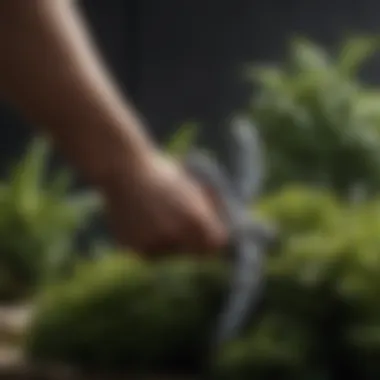Choosing the Best Hedge Shears for Gardening


Overview of Topic
When diving into the world of gardening, one often overlooks the tools that shape its beauty. Among these, hedge shears play a pivotal role in maintaining not just the aesthetics, but the health of plants as well. Hedge shears are specialized cutting tools designed to trim and shape hedges and shrubs. They come in various designs – from bypass to anvil shears – and understanding each type is crucial for enhancing your garden's appeal.
The importance of selecting the right hedge shears cannot be understated. Using the wrong type can lead to damaged plants or inefficient results. Whether shaping up a sprawling hedge or maintaining the neatness of a small shrub, the right tool makes all the difference. From professionals to casual gardeners, everyone benefits from understanding how to select the proper shears based on their specific needs.
Common Challenges and Solutions
Homeowners often face multiple hurdles when it comes to caring for their hedges:
- Poor performance: Many individuals find their shears dull after a few uses. This can result in tearing rather than clean cuts, leading to plant distress.
- Handle Discomfort: Using shears that don't fit well can cause hand fatigue and muscle strain, making a chore out of something that should be enjoyable.
To address these common pitfalls, here are some actionable solutions:
- Invest in High-Quality Blades: Opt for stainless steel or carbon steel blades, as they resist corrosion and maintain sharpness longer.
- Prioritize Ergonomic Designs: Look for shears that offer padded handles or those shaped to fit the natural grip of the hand. This may seem minor but significantly enhances comfort during long sessions.
Product Recommendations
When selecting hedge shears, several top brands stand out in the market. Their commitment to quality and user satisfaction has made them favorites among gardeners:
- Fiskars PowerGear2: Known for its innovative gear mechanism, this model gives added power for those thicker branches. The lightweight design makes it easy to manipulate, perfect for lengthy trimming tasks without fatigue.
- Felco F-2 Classic: A staple in the gardening world, the Felco brand is well-regarded for its durable design and effective cutting performance. The blades are easily replaceable, extending the life of the tool tremendously.
- Bahco P34-17: The Bahco shears feature a bypass design, providing precision without crushing stems. The handles are coated for grip, ensuring a solid hold during use.
Benefits and features of these products include:
- Superior cutting power and blade sharpness
- User-friendly ergonomic designs for reduced strain
- Long-lasting materials that stand the test of time
Step-by-Step Guides
To maximize the effectiveness of hedge shears, it's crucial to follow certain steps when using them:
- Choose the Right Time: Trim hedges during their dormant season (typically late winter or early spring). This ensures healthy regrowth without stressing the plant.
- Inspect and Maintain: Before you start, check the blade for any signs of rust or dullness. Sharpen the blades regularly and clean them after each use to avoid sap build-up.
- Cut with Strategy: When trimming, always start with the tallest parts and work your way down. This allows you to visualize the final shape better and prevent excessive cutting on one section.
- Aim for Clean Cuts: Make sure to cut branches at a slight angle. This helps reduce surface area for pruning wounds and promotes faster healing for plants.
By understanding the nuances of hedge shears, a homeowner can not only maintain their garden but also create an inviting outdoor haven. In the end, choosing the right shears becomes an integral part of the gardening experience.
Understanding Hedge Shears
Hedge shears are indispensable tools in gardening and landscaping. The proper pair can make the difference between a frenzied afternoon of yard work and a harmonious trimming experience. Understanding what hedge shears are and the types available lays the groundwork for selecting the right tool for your project. The right shears can enhance your gardening efforts, allowing you to achieve the desired shape and health of your hedges and bushes.
Defining Hedge Shears
Hedge shears are primarily designed for trimming and shaping hedges and shrubs. With their long blades, these tools offer a striking advantage over smaller pruning shears, enabling users to take on larger foliage without breaking a sweat. The blades come in varying lengths and designs, which can affect cutting performance significantly. They often feature a dual-blade construction that can provide clean, precise cuts. Simplicity of use and effectiveness contribute to their popularity among both novice and experienced gardeners.
Types of Hedge Shears
Hedge shears come in several varieties, each serving specific purposes and fitting different user preferences. Understanding these types can help in selecting the right tool for individual needs.
Manual Hedge Shears
Manual hedge shears are the traditional choice, relying solely on human power for operation. Despite technological advancements, they remain a favorite among many gardeners. These tools are lightweight and offer better control over precision cuts. Their lack of complex mechanisms means they require minimal maintenance.
One of the more appealing characteristics is their affordability. They're often seen as a gateway tool for novice gardeners looking to get their hands in the soil without breaking the bank. However, they can become tiring if you have extensive hedging tasks due to the physical effort involved.
“Sometimes, the simplest tools offer the most satisfaction.”
Electric Hedge Shears
Electric hedge shears are perfect for those who value convenience and efficiency. Plug them into a socket or rely on batteries, and they can slice through branches with relative ease. The key aspect of electric models is their power, significantly reducing the time spent on larger tasks.
Nevertheless, they can prove less effective on thicker branches. Another consideration is the need for a wild extension cord if opting for corded versions, which might limit your movement while trimming.
Gasoline-Powered Hedge Shears
Gasoline-powered hedge shears are a powerhouse for large-scale operations. Typically more robust, they can handle thicker branches without breaking a sweat. The most notable characteristic is their mobility. There’s no cord to trip over, and they can function anywhere as long as you've fueled them up. This makes them a popular choice for commercial landscapers.
However, their weight can make them cumbersome for residential use. Noise levels often rise considerably, which may disrupt the tranquility of your surroundings. Weighing these pros and cons is essential for the discerning homeowner.
Telescoping Hedge Shears
For those who find reaching high hedges a challenge, telescoping hedge shears are life-savers. These tools can extend in length, allowing access to previously unreachable branches. Their design maintains a comfortable grip while providing flexibility in use.
The striking trait of telescoping shears is that they combine convenience and versatility. Homeowners can shape hedges from a safe distance, ensuring they don't overextend themselves physically. However, they can sometimes feel unstable if fully extended, requiring users to exercise caution.
In summary, knowing the various types of hedge shears helps guide consumers towards the best match for their gardening styles and needs. Making a decision becomes less daunting once you understand the strengths and weaknesses of each option.
Critical Features to Consider
Selecting the right hedge shears isn't just about aesthetics; it’s about functionality and performance. Understanding critical features is key for anyone looking to enhance their gardening experience. You have to look closely at what makes a shearing tool effective for your specific needs, which can lead to a more satisfying outcome in your garden. Here are some features that can significantly impact your selection process.
Blade Material and Design


Choosing the right material for the blades is crucial. You don’t want them to dull quickly or rust, and that’s why materials like stainless steel and carbon steel come into play. Each has its own merits and shortcomings, but it boils down to what you need.
Stainless Steel Blades
Stainless steel blades are often celebrated for their resistance to rust. This means you can leave your shears outside without worrying about degradation. Their smooth finish allows for clean cuts, making them particularly favored for delicate trimming tasks.
- Key Characteristic: Rust resistance is a standout trait.
- Advantages: Less maintenance needed. They naturally resist corrosion from water and dirt.
- Disadvantages: Often, they are a bit more expensive than carbon steel options. If they’re not well cared for, they can still dull over time.
Carbon Steel Blades
On the flip side, carbon steel blades are known for their sharpness. They often hold an edge longer than their stainless counterparts but require more attention to prevent rust.
- Key Characteristic: Superior sharpness and edge retention.
- Advantages: Can make cleaner cuts on thicker branches, making them ideal for heavier pruning tasks.
- Disadvantages: They necessitate regular maintenance and cleaning to prevent rust.
Blade Geometry Effects
The design of the blade, or blade geometry, plays a major role in how effective your cuts will be. Different shapes can affect not only the cutting action but also the fatigue on your hands.
- Key Characteristic: Varying blade shapes provide different cutting experiences.
- Advantages: A well-designed blade can offer more efficient cuts with less effort.
- Disadvantages: Some designs might be specialized and not versatile for varied trimming tasks.
Handle Comfort and Length
When you're using hedge shears, comfort isn't just a bonus; it's a necessity. If your tools lead to sore hands and fatigue, you won’t be very motivated to get the job done. Hence, the design of the handle is pivotal.
Ergonomic Designs
Ergonomic handles are designed to fit comfortably in the hand, reducing strain during use. If you've ever used a tool that felt awkward, you know how quickly that can ruin an afternoon outdoors.
- Key Characteristic: Comfort-driven design.
- Advantages: Helps to minimize fatigue, allowing for longer trimming sessions without discomfort.
- Disadvantages: These models may come at a higher price point compared to standard designs.
Handle Length Variations
Handle length can have a significant impact on your shearing capability. Longer handles can give you more reach but could also lead to decreased control.
- Key Characteristic: Different lengths cater to various tasks and user preferences.
- Advantages: Extended reach for taller hedges or deep areas in gardens.
- Disadvantages: Shorter people may find long handles unwieldy, affecting functionality.
Weight and Balance
The weight of the shears can affect not only how easily you can maneuver them but how much strain you'll place on your body.
Lightweight Options
Lightweight hedge shears may be ideal for most home gardening tasks. They can reduce the fatigue of repeated use, making them a fantastic choice for those who do a lot of trimming.
- Key Characteristic: Easy to handle for extended periods.
- Advantages: Great for beginners or those who want to maintain their energy for longer projects.
- Disadvantages: May lack the heft needed for tougher jobs, potentially leading to bending or breaking with heavy use.
Heavy-Duty Models
For homeowners who encounter tougher jobs, heavy-duty models may be the way to go. These tend to be sturdier and capable of taking on thicker branches without much fuss.
- Key Characteristic: Built for resilience and capable of handling demanding tasks.
- Advantages: Suitable for commercial applications or intensive gardening activities.
- Disadvantages: They can be more challenging to wield over long periods, adding physical strain to users.
In summary, understanding these critical features will arm you with the knowledge to make a more informed choice, aligning your gardening tasks with the right tools that will serve you well in the long haul.
Evaluating Performance
When it comes to hedge shears, knowing how to evaluate their performance can save you a lot of time and effort in the garden. This section is about understanding the real muscle behind your shears—the effectiveness with which they can tackle the tasks needed to beautify your outdoor spaces. If you pick a tool that doesn’t perform well, it could lead to frustration, wasted money, and that ever-dreaded overgrown hedge situation. Let’s break it down.
Cutting Efficiency
Types of Cuts
Different hedges call for different types of cuts. There are really three major approaches: shaping, trimming, and pruning. Each has its own purpose and unique requirements.
- Shaping is about giving a hedge a stylish silhouette. You want clean lines, and that means using shears that can make precise cuts without jagged edges.
- Trimming generally refers to maintaining the overall size of a hedge and removing any stray branches. This is where the tool's snipping ability shines.
- Pruning, on the other hand, is a bit like giving your hedge a haircut. It’s more about removing older wood to encourage new growth.
In this guide, those distinctions are critical because they determine what kind of tool you should lean toward. A shear that excels at shaping might not be the best for trimming overgrown branches—this is where the versatility of your selection comes into play.
Another important factor is sharpness; shears that can stay sharper longer make cleaner cuts, which means healthier plants. Poor cutting efficiency can lead to damages that invite pests and diseases.
Effectiveness on Different Foliage
Understanding how your shears react to various foliage types is vital. Different leaves, branches, and overall hedge structures have distinct thicknesses and textures, which can influence how easily they can be cut.
- Soft, thin foliage tends to yield easily to sharper blades, allowing for a swift and smooth cutting experience. For instance, boxwood hedges, which are popular for their dense growth, require shears that can navigate their tight spaces.
- Thick, woody branches, like those found in privet hedges, call for a sturdier approach. Having the right leverage and strength in your shears ensures that they can handle the added challenge. Electric or gas-powered shears often make quick work of these heavier tasks, though they come with their own noise considerations.
When selecting hedge shears, knowing their effectiveness on different types of foliage helps you decide whether you need manual precision or powered strength. This knowledge leads you to make choices that can greatly influence the health and aesthetic of your garden.
Noise Levels
Comparative Analysis of Electric vs. Gas-Powered Models


Noise is another element often overlooked when assessing hedge shear performance. Different types of models typically generate varying sound levels. In this context, we compare electric and gas-powered hedge shears.
Electric shears are generally quieter and more user-friendly, making them great for residential gardens. If you live in a close-knit neighborhood, the last thing you want is to rattle the neighbors with a roar. Electric shears do the job without turning your gardening into a loud spectacle.
Gas-powered models, in contrast, pack a punch and can handle larger jobs but do so with the sound of a mini jet engine. They’re more suited for heavy-duty tasks, perhaps within a commercial landscape setting, where noise is less of a concern.
On top of noise, both options have power considerations. Gas models might still be the king of sheer cutting power, but if your goal is more about ease and quick maintenance of smaller residential tasks, electric models may serve you better.
Keep these factors in check when evaluating hedge shear performance; understanding them can lead to a more enjoyable and efficient gardening experience.
Key takeaway: Choosing the right hedge shear entails understanding type-specific efficiencies and balancing cutting capabilities with operational noise levels.
Selecting Based on Use Cases
When it comes to hedge shears, choosing the right type can make all the difference in your gardening experience. This section underscores the importance of selecting based on specific use cases. Depending on what you plan to do—be it maintaining a backyard garden or managing a commercial landscape—the requirements and tools can vastly differ. Grasping these elements helps to ensure efficiency and satisfaction in your gardening efforts.
Landscaping Needs
Residential Gardens
Residential gardens often serve as a retreat from the hustle and bustle of daily life. For many homeowners, the goal is to create a cozy, visually pleasing space. This type of gardening commonly involves smaller shrubs and hedgerows, making manual or electric hedge shears particularly suitable here. The key characteristic of residential gardens is their intimate scale. This makes them a popular choice among homeowners who wish to engage in hands-on gardening activities.
One specific aspect of using hedge shears in residential gardens is their ability to create clean, precise cuts that foster healthy growth patterns. A unique feature here is the variety of small shears designed for detail work, allowing you to shape hedges into aesthetically pleasing designs. Their advantage? You get to exert personal control over your greenery, which is both satisfying and rewarding. However, the consideration of ergonomics is vital, as a long, tiring trimming session can take the joy out of the task.
Commercial Landscaping
On the other end of the spectrum, commercial landscaping requires a different approach altogether. The key characteristic of commercial settings is their need for efficiency and effectiveness in maintaining larger and often more diverse landscapes. Electric or gasoline-powered hedge shears are typically favored here due to their capability to handle rigorous tasks more rapidly. They are beneficial in terms of productivity, especially when faced with larger jobs that demand swift action.
When you look at equipment for commercial landscaping, heavy-duty models often shine. They can tackle different types of foliage without breaking a sweat, allowing landscapers to keep to tight schedules. However, the downside could be increased weight and noise levels, which may be a concern in residential spaces adjacent to commercial properties. Understanding the unique demands posed by commercial landscaping can help in making the right hedge shear choices.
Maintenance and Pruning
Routine Hedge Maintenance
Routine hedge maintenance is fundamental in sustaining the appearance and health of your plants over time. Regular trimming with the right kind of shears prevents overgrowth and keeps hedges in check, allowing for neat, well-manicured borders. This key characteristic of routine maintenance makes it a beneficial choice for busy homeowners who want to maintain a tidy garden without a significant time investment.
The unique feature of routine maintenance is that it allows for proactive care rather than reactive work. Ideally, hedging should occur multiple times a year, and by utilizing quality tools, you're less likely to face issues like stubborn overgrowth. Neglect here can lead to longer prunings later, which can be tiring and time-consuming. Regular maintenance with suitable equipment makes the task less daunting in the long run.
Seasonal Pruning
Seasonal pruning takes the care routine a step further. It’s about timing; pruning at the right time of year supports healthy plant development and enhances growth cycles. The key characteristic of seasonal pruning is its adaptability, providing plants the time they require to rejuvenate while preparing them for the next season's needs. This approach is a popular choice for those looking to cultivate a thriving garden over time.
When we discuss seasonal pruning, the unique aspect comes from understanding your plants' life cycles. In this sense, different hedges will react differently based on when and how they’re pruned. Although a bit more complicated than regular maintenance, the advantages are manifold: healthier plants, better growth, and a more vibrant hedgerow come springtime. On the flip side, it can also require an investment of time and effort, which some homeowners may find challenging.
Ultimately, whether you're managing a quaint residential garden or overseeing a sprawling commercial landscape, understanding use cases for hedge shears will pave the way to healthier, more beautiful greenery.
By considering landscaping needs and maintenance strategies, you can make more informed decisions, ensuring that your shears serve you well for years to come.
Top Recommendations for Hedge Shears
When it comes to maintaining a stunning garden or perfectly trimmed hedges, choosing the right hedge shears becomes crucial. This section narrows down some top recommendations that stand out in the crowded field of gardening tools. Users benefit greatly from informed choices that take into account several elements, such as cutting efficiency, comfort during use, and the durability of materials. Each recommendation considers the specific needs of gardeners, whether they're tackling a small residential plot or managing larger landscaping tasks.
Best Manual Hedge Shears
Top Picks Overview
Manual hedge shears are a staple for those who appreciate the art of gardening and enjoy the tactile feel of cutting by hand. Sometimes, simple things do the job best. Top picks in this category often showcase high-quality construction, light weight, and superior blade sharpness. For instance, a popular choice among gardening enthusiasts includes the Fiskars HS8667 PowerGear2 shear, well-known for its innovative gear technology that multiplies leverage, making cuts easier even on tough branches.
Unique Features: One of the standout features of this model lies in its ergonomic handle design that reduces hand fatigue, allowing users to prune longer without discomfort. However, not everyone may appreciate the manual effort required for larger hedge maintenance, making it susceptible for anxious gardeners wanting a quick fix.
User Reviews and Feedback
User feedback plays a significant role in shaping opinions about gardening tools. Most reviews praise the longevity and performance of the Fiskars HS8667, remarking on how it holds its edge even after hours of use.
Key Characteristics: It often stands out because users mention its lightweight nature, which accelerates work, allowing them to tackle extensive tasks without tiring out. However, some reviews highlight its performance on thicker branches as a con, asserting that users sometimes need to switch tools when faced with particularly stubborn wood.
Best Electric Hedge Shears
Feature Comparisons
Electric hedge shears have revolutionized the way gardeners approach trimming tasks. A standout in this section is the Black+Decker BEHT200, which excels with its powerful motor and dual-action blades that cut through stubborn hedges effortlessly.
Unique Features: Specifically, the lightweight design combined with a corded power source allows continuous use without worrying about battery life. This feature makes it a sought-after choice, especially for larger jobs. However, this model might restrict movement due to the cord length, posing challenges in larger gardens.
Performance Analytics
Evaluating the performance of electric hedge shears like the Black+Decker BEHT200 brings to light their cutting effectiveness compared to manual alternatives. User reviews reflect high satisfaction regarding its swift cutting capabilities, providing a clean and tidy finish to hedges.
Key Characteristics: The ease of use contributes significantly to its popularity, especially among novice gardeners. However, some seasoned users note that it can be a bit noisy compared to manual options, which might be a consideration for those living in quieter neighborhoods.
Best Gas-Powered Hedge Shears


Power Ratings
Gas-powered shears tend to pack more punch than their electric and manual counterparts, making them ideal for larger yards and tougher hedges. A leading example is the Echo HCAS-210, known for its high power ratings that translate into performance.
Unique Features: The strong engine can cut through thicker branches with relative ease, greatly speeding up the trimming process. However, the downside involves the need to handle fuel, making them a bit less convenient compared to electric alternatives.
Durability Tests
Durability is a vital consideration in selecting gas-powered options like the Echo HCAS-210. Users often comment on its robust build, evaluating its performance over time. For those who push their tools to the max, reviews indicate this model retains its effectiveness after extensive use.
Key Characteristics: Specifically, its metal design stands up against wear and tear, while users also benefit from easy access for maintenance. Still, the tool's weight can be a downside for some, requiring a bit of muscle and endurance for prolonged usage.
The right selection of hedge shears can elevate your gardening game, turning tasks from daunting to delightful.
Maintenance and Care for Hedge Shears
When it comes to hedge shears, proper maintenance and care are paramount. Just like a car needs regular tune-ups, your garden tools need attention to function effectively for years to come. Neglecting maintenance can lead to poor performance, rusting, and ultimately, the need for costly replacements.
Keeping your shears in top condition not only saves money but also ensures that your garden looks its best. A well-maintained tool can make clean, precise cuts that are essential for healthy plant growth. This section will cover valuable practices to keep in mind for preserving your hedge shears, making sure they serve you well over time.
Cleaning Techniques
Post-Use Cleaning
After a long day clipping hedges, it's easy to toss your shears into a shed without a second thought. However, post-use cleaning is crucial for maintaining the efficacy of your shears. It involves removing any plant debris, sap, or dirt that may be stuck to the blades after you’ve trimmed your hedges.
A key characteristic of post-use cleaning is its simplicity. It merely requires a cloth or soft brush and some warm, soapy water. This practice becomes distinctly beneficial as it minimizes the risk of corrosion and keeps the mechanisms functioning smoothly. By regularly cleaning, you avoid unnecessary buildup, which can hinder performance; in the long run, that's always a huge plus.
One unique feature of post-use cleaning is how it also allows you to inspect your blades for any nicks, dents, or signs of wear. Regular checks mean you can address potential issues before they become critical problems. In contrast, neglecting this easy cleaning step leads to diminished tool life and potentially disappointing results in your gardening endeavors.
Rust Prevention
Rust is the enemy of metal tools. Rust prevention plays a vital role in the longevity of hedge shears, especially if they are made from carbon steel, which is more prone to rusting than stainless steel. Keeping your blades free of moisture is essential; hence regular drying after cleaning is key.
The primary characteristic of rust prevention methods is the application of an oil or lubricant. Using a light machine oil or dedicated tool oil can create a protective layer on the metal, preventing moisture from making contact. It's a beneficial choice because it not only helps guard against rust but also ensures the shears move smoothly during use.
A unique aspect of rust prevention is that it can become a secondary benefit as well—those oils can also aid in keeping the shears clean by repelling dirt and debris, making future cleaning easier. However, a downside could be the necessity of applying oil frequently, as this task can be somewhat easily overlooked.
Sharpening Blades
Having sharp blades is everything when using hedge shears. Manual sharpening methods emphasize the importance of keeping blades sharp for clean cuts. Regularly sharpening your shears not only enhances cutting efficiency but also reduces stress on your hands, providing a better overall experience.
The essential characteristic of manual sharpening methods is the need for consistent practice. Using a sharpening stone or file allows for precise control over how much material is removed from the blades. It can be a beneficial route if you're looking to customize the sharpness to your preferences. However, it does take some skill to master this technique and improper use can lead to dullness rather than improvement.
On the other end, turning to sharpening tools like electric sharpeners offers a unique feature; faster results with less input effort. Although these tools are easier for most users, they can also produce heat that may affect the metal properties of your blades, possibly compromising their integrity.
Storage Recommendations
Once you’ve given your hedges a fresh trim, the manner in which you store your shears plays a part in their overall life span. Ensuring optimal storage conditions can prevent damage from humidity, dirt, or even accidental mishaps.
A key characteristic is that tools should be stored in a dry, indoor area when not in use. Utilizing a sheath or storage container designed for garden tools can greatly enhance their protection. A beneficial component of proper storage is that it keeps shears accessible without risking injury or damage, helping to maintain your gardening flow.
A unique advantage of good storage habits is that they promote organization within your shed or garage. No more searching endlessly through a heap of tools. However, it does require a bit of discipline to ensure tools are returned to their designated spots.
Avoiding Damage During Storage
Avoiding damage during storage is another critical aspect that shouldn’t be underestimated. This involves ensuring that shears are not placed against hard surfaces that could cause nicks or bends to the blades. Protecting the cutting edges helps maintain their integrity.
One characteristic of this practice is the usage of covers or sheaths. These can be a beneficial choice, as they prevent accidental cuts or scratches while providing a cushion against impacts. A downside could be that if you store shears stacked together, they can still potentially collide and cause issues, emphasizing the need for some thoughtful organization.
Ultimately, clear practices for maintenance and care for hedge shears can extend their usable life and enhance your gardening experience. Taking the time for cleaning, sharpening, and proper storage ties into a more efficient and satisfying relationship with your gardening tools, ensuring you're not left in a lurch when the plants need tending.
The End: Making an Informed Choice
In the landscape of gardening and landscaping, the choice of hedge shears can significantly impact both efficiency and the quality of the results. Every gardener, whether a seasoned pro or just starting, stands to gain from understanding not just how to select the right tools, but why those tools matter. This section underscores the necessity of making informed decisions when choosing hedge shears by highlighting key elements that can affect performance and satisfaction.
Summarizing Key Points
A well-rounded understanding of hedge shears involves recognizing their various types, such as manual, electric, and gasoline-powered options. Each type presents its own advantages and disadvantages, tailored to different tasks and user preferences. When considering features, factors like blade material, handle comfort, and weight play crucial roles in the comfort and effectiveness of these tools.
Additionally, the importance of maintenance should be stressed. Regular cleaning, sharpening, and proper storage not only prolong the lifespan of hedge shears but also ensure they perform at their best, making gardening tasks easier and more enjoyable. In brief, a comprehensive grasp of these elements facilitates informed decision-making, ultimately leading to better outcomes in gardening endeavors.
Future Considerations in Hedge Shears Technology
Potential Developments
The field of garden tools, particularly hedge shears, is poised for exciting advancements. One potential development to watch is smart technology integration. Imagine hedge shears that can connect to your smartphone via Bluetooth, allowing users to monitor and manage battery life, as well as receive alerts when maintenance is due. This advancement could significantly elevate user experience while offering insights into performance metrics.
The key characteristic of such innovations is their ability to enhance usability. By simplifying the way gardeners interact with their tools, potential developments in smart technology prove to be popular choices among enthusiasts looking for efficiency and ease of use. However, these tools may also come with higher price tags, which could deter some. Still, the benefits of increased functionality and efficiency make smart hedge shears an appealing prospect for modern gardeners.
Sustainability Trends
Another significant aspect to consider is the growing emphasis on sustainability in tool manufacturing. Many brands are starting to explore eco-friendly materials and manufacturing processes. Reducing the carbon footprint in production helps align gardening practices with environmental consciousness. Some manufacturers now focus on recyclable materials for handles and blades, aiming to minimize waste and pollution.
Sustainability trends offer the unique feature of aligning gardening with broader environmental aims. As consumers become increasingly aware of their ecological impact, the demand for sustainable options has surged. These tools not only cater to the eco-conscious user but also significantly promote efficient gardening practices. On the downside, sustainable models sometimes have limited availability or come with higher upfront costs. Despite these drawbacks, the long-term benefits for both users and the environment present a compelling case in favor of this innovation.
Ultimately, the future of hedge shears appears geared towards functionality and sustainability, ensuring that gardening keeps pace with technological and ecological advancements.







